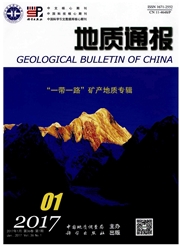

 中文摘要:
中文摘要:
在系统分析青藏高原及邻区古新世残留盆地类型、形成构造背景、岩石地层序列的基础上,对青藏高原古新世构造岩相古地理演化特征进行讨论:青藏高原西北部的西昆仑,北部的阿尔全、祁连、西秦岭,东北部的松潘-甘孜和南部的冈底斯陆缘弧带,以及北部的阿拉善古陆和南部的上扬子古陆和印度古陆为隆起剥蚀区。西宁-兰州、成都和班戈地区零星分布个别构造压陷湖盆。高原西部和南部为新特提斯海。南部的特提斯-喜马拉雅海区的古地理格局为萨嘎以西为残余洋盆。以东为前陆盆地。由此提出,白垩纪晚期-古新世印度板块与欧亚板块的碰撞起始于东部构造结,新特提斯洋的闭合是自东向西进行的。
 英文摘要:
英文摘要:
Based on an integrated study of the geological maps and previous achievements, the authors analyzed the attributes, tectomc settings and lithofacies-stratigraphic sequences of the renmant basins in the Tibetan plateau. In Paleocene, the Tibetan Plateau was characterized by the erosional areas in western Kunlun, Altun, Qilian, western Qinling, Songpan-Garze and Gangdise, the Alxa and Indian ancient lands and the depressed basins (lakes and pluvial plains) in Xining-Lanzhou, Chengdu and Baingoin. There existed Neo-Tethyan remnant sea in western and southern Tibetan Plateau. It is held that the paleogeography of the Neo-Tethyan remnant sea was a remnant oceanic basin to the west of the Saga area and a foreland basra to the east of Saga during the Paleocene. The authors argue that the closure of the Neo-Tethys progressed from east to west.
 同期刊论文项目
同期刊论文项目
 同项目期刊论文
同项目期刊论文
 Pre-Rodinia supercontinent Nuna shaping up: A global synthesis with new paleomagnetic results from N
Pre-Rodinia supercontinent Nuna shaping up: A global synthesis with new paleomagnetic results from N Extended stratigraphy, palynology and depositional environments record the initiation of the Himalay
Extended stratigraphy, palynology and depositional environments record the initiation of the Himalay Systematics and palaeoecology of Changhsingian (Late Permian) Ambocoeliidae brachiopods from South C
Systematics and palaeoecology of Changhsingian (Late Permian) Ambocoeliidae brachiopods from South C Climatic and tectonic uplift evolution since similar to 7 Ma in Gyirong basin, southwestern Tibet pl
Climatic and tectonic uplift evolution since similar to 7 Ma in Gyirong basin, southwestern Tibet pl Organic carbon isotope constraints on the dissolved organic carbon (DOC) reservoir at the Cryogenian
Organic carbon isotope constraints on the dissolved organic carbon (DOC) reservoir at the Cryogenian How severe is the modern biotic crisis? - A comparison of global change and biotic crisis between Pe
How severe is the modern biotic crisis? - A comparison of global change and biotic crisis between Pe Environmental determinants and ecologic selectivity of benthic faunas from nearshore to bathyal zone
Environmental determinants and ecologic selectivity of benthic faunas from nearshore to bathyal zone Diagenetic control of magnetic susceptibility variation in Core MD98-2172 from the Eastern Timor Sea
Diagenetic control of magnetic susceptibility variation in Core MD98-2172 from the Eastern Timor Sea Sedimentary geochemistry and provenance of the Lower and Middle Devonian Laojunshan Formation, the N
Sedimentary geochemistry and provenance of the Lower and Middle Devonian Laojunshan Formation, the N Paleogene-Neogene stratigraphic realm and sedimentary sequence of the Qinghai-Tibet Plateau and thei
Paleogene-Neogene stratigraphic realm and sedimentary sequence of the Qinghai-Tibet Plateau and thei Zoophycos composite ichnofabrics and tiers from the Permian neritic facies in South China and south-
Zoophycos composite ichnofabrics and tiers from the Permian neritic facies in South China and south- Palaeoecology and taphonomy of two brachiopod shell beds from the Anisian (Middle Triassic) of Guizh
Palaeoecology and taphonomy of two brachiopod shell beds from the Anisian (Middle Triassic) of Guizh Isotopic evidence for an anomalously low oceanic sulfate concentration following end-Permian mass ex
Isotopic evidence for an anomalously low oceanic sulfate concentration following end-Permian mass ex Provenance record of a foreland basin: Detrital zircon U-Pb ages from Devonian strata in the North Q
Provenance record of a foreland basin: Detrital zircon U-Pb ages from Devonian strata in the North Q Revised conodont zonation and conodont evolution across the Permian-Triassic boundary at the Shangsi
Revised conodont zonation and conodont evolution across the Permian-Triassic boundary at the Shangsi Microbial lipid records of highly alkaline deposits and enhanced aridity associated with significant
Microbial lipid records of highly alkaline deposits and enhanced aridity associated with significant The origin of decoupled carbonate and organic carbon isotope signatures in the early Cambrian (ca. 5
The origin of decoupled carbonate and organic carbon isotope signatures in the early Cambrian (ca. 5 Microbial response to limited nutrients in shallow water immediately after the end-Permian mass exti
Microbial response to limited nutrients in shallow water immediately after the end-Permian mass exti Morphological association of microbially induced sedimentary structures (MISS) as a paleoenvironment
Morphological association of microbially induced sedimentary structures (MISS) as a paleoenvironment Geochemical evidence from bio-apatite for multiple oceanic anoxic events during Permian-Triassic tra
Geochemical evidence from bio-apatite for multiple oceanic anoxic events during Permian-Triassic tra 期刊信息
期刊信息
